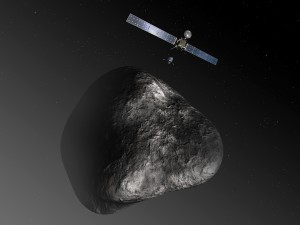
Artist’s impression of the Rosetta spacecraft at its destination, Comet 67P/Churyumov-Gerasimenko. The picture is not to scale; the spacecraft's solar arrays have a span of 32 meters; the diameter of the nucleus is about four kilometers.
The Philae comet lander has been successfully reactivated and broke its planned radio silence by sending data to Earth on March 28.
Europe’s Rosetta spacecraft — with the Philae lander on board — has been making its way through space since March 2004 to investigate Comet 67P/Churyumov-Gerasimenko.
What exactly is to be expected on arrival in August 2014 and Philae’s landing in November 2014 is still not known.
More than two and a half years – this is how long the Philae lander has been hibernating while travelling through space, according to a German Aerospace Center (Deutsches Zentrum für Luft- und Raumfahrt (DLR) press statement.
The lander will be deployed onto 67P/Churyumov-Gerasimenko while the Rosetta spacecraft orbits the comet.
The comet has an average diameter of about four kilometers and is shaped like a giant potato. The comet rotates about its axis once every 12.6 hours.
Harpoons and ice screws
The orbiter and lander will be the first to witness a comet’s “awakening” as it approaches the Sun first hand – and warms up the celestial wanderer.
Once Rosetta is in orbit around the comet, the search will begin for a suitable landing site for Philae. The selected site must allow a safe landing, but at the same time provide a location that the scientists find exciting to study.
Philae is prepared to deal with the various surface materials it might encounter – harpoons and ice screws will be used to anchor the lander to the landing site before it begins taking measurements.
The European Space Agency (ESA) is responsible for this international mission with contributions from its member states and NASA, including major participation by Germany.
By Leonard David
Photo credit: ESA–C. Carreau/ATG medialab.
